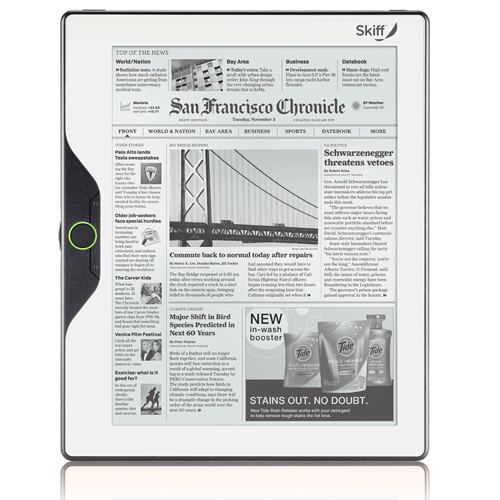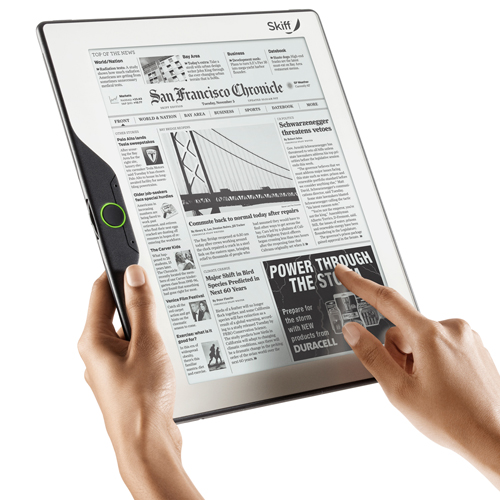Skiff's eReader and Service Demoed: Device and Service Could Reinvent Print Media

Do you know Skiff? It's the Hearst-sponsored initiative to insert magazines, newspapers, and blogs into the book publishing industry's nascent shift toward digital content. Mostly Skiff is associated with a new eponymous ereader, but at a meeting with the folks behind both that device and the content distribution service it will leverage, the message was clear: Skiff will not be defined by its ereader.
But, About That Reader
Still, thanks to a Pre-CES press release featuring alluring details about the potential upstart device, the word "ereader" is where the buzz lies, and I can't speak about the meeting without telling you a few quick facts about the device, which unfortunately I was not allowed to photograph:
- Flexible screen, but rigid body: The new stainless-steel foil e-ink display is more flexible than a Cirque du Soleil dancer but, because the screen is locked inside the standard plastic ereader frame, the device itself does not warp at all, in fact it's as rigid as any old Amazon Kindle
- Fantastic, high-res picture: The 11-inch screen (the largest in the reader league) and it's resolution of 1200 x 1600 are clearer than many other readers we've seen, and scanning digitized newspaper and magazine layouts, even without color, was a good approximation to reading the paper on your kitchen table
- Available this year, but no release date: The Skiffers told me that the ereader is definitely coming in 2010 but right now, no, there's no definite date for the Skiff to be released to market.

Looks Good, But Not Ready for Public Yet
Though the Skiff reader flashed through pages of the Wall Street Journal in a blaze of familiar newspaper-ish, rectangular-based layouts, moving almost a split-second after the rep who demo'ed the product swiped his finger on the screen, I couldn't replicate his performance when I had a chance to play with it.
When I got my hands on the reader, I could only change the page about a third of the time, with a similar success rate for pushing the screen directly with my index finger to open The New York Times or other papers populated on the home screen. So, no, it's not ready for prime time yet, but, with the rep behind the touchscreen, the functionality looked very promising.
Using the Device: Some Glimpses of the Finished Product
Stay in the know with Laptop Mag
Get our in-depth reviews, helpful tips, great deals, and the biggest news stories delivered to your inbox.
Speaking of functionality, here are some highlights for navigating the device.
- Buttons and wheel: The three buttons and clickwheel along the right side of the frame are used primary to open up nav menus, select items, and scroll through selections. Moving through content is performed on the touchscreen primarily.
- Scrubber bar: When documents are open, you can pull up a scrubber bar along the bottom of the screen that lets you move from page to page by either dragging your finger along a stream of pages or tapping a particular point in the line.
- Reading experience: Select a newspaper to read and it's front page appears in glorious full view. You can either turn the page by swiping your finger forwards, select an article and have it displayed full-page style on the screen, or use the scrubber bar to run that gauntlet of content. With magazines, it's either page-to-page movement or the scrubber bar.

Rich, Interactive Ads In a Print Layout
The Skiff is more than an ereader device; it also represents a whole new venue for print media. Its backers are pushing to port the print industry's business model over to digital devices.
The folks at Skiff want their pixel-based magazines and newspapers to come with an advertising experience that is similar to what exists in their paper counterparts, but with added interactive elements. The result: as we browsed through Wall Street Journal, an Audi ad called to readers with deep pockets. When we clicked it, the ad opened up to a full page view that included the same information from the orginal 1/4th-page sized block of image and text, but now there was also more interactive content.
In the middle of the page was a map alerting future Audi drivers to nearby dealerships. This sort of web-powered, multimedia-rich, location-aware triple-decker functionality is what Skiff wants to leverage to re-juice advert sales in a different context.
Rich Media for Editorial Content, Support For More Devices
The company wants to infuse traditional magazine layouts with the same web-enriched multimedia experience for reader content as well as advertising. Some of these elements may be even more exciting on color devices.
The good news is that the Skiff service is also designed to work on a variety of platforms, some of which may already be sitting in your pocket. I saw it in action on the Palm Pre and a Viliv MID. In both cases the content, magazine pages from a Hearst-owned publication, was in full-color and looked vibrant and fresh (and naturally, the Skiff service will sync between multiple devices to save your pages and identify your favorite or most-accessed content).
However, the real fun was limited to the Viliv MID, which had access to the full web. On that handheld, the rep loaded pages of the magazine with visual elements of the layout gliding into place smoothly or floating around text. On another page, he tapped an image of actress Gillian Jacobs and launched a video clip that played within the layout of the magazine.
As explained to me, the idea of that video clip is Skiff's ultimate goal: to use interactive media functions of the web to enrich print media, and not merely port the experience of reading a magazine or paper to a web-enabled device.
Pricing: No Details Yet
When I met with Skiff, a Sprint representative sat in on the discussion. I got to ask both parties what the cost of admission for the Skiff reader will be. Taking advantage of Sprint's EV-DO network has always been a part of Skiff plan. The service rides on delivering books and magazines, newspaper editions via over-the-air downloads. I speculated last week, that because the Skiff will be sold in Sprint stores and on Sprint.com, it may also be sold with a data plan from that carrier. I was told that's not the case. Skiff has stepped up to absorb the cost of the data connection within the fees they charge for content. The company intends to work via a number of publishers to provide books, magazine, and newspaper subscriptions, and it hopes to focus on long-term subscription models not just one-time purchases.
There's no word yet on pricing for the Skiff device itself or its content. However, if Hearst can pull off it's plan to make print publications more digitally relevant across a variety of platforms, the eReader itself could be the least interesting part of this story.
Kenneth was a Social Media Editor at Laptop Mag. Outside of his limitless knowledge of social media, Kenneth also wrote about a number of tech-related innovations, including laptop reviews (such as the Dell XPS or the Acer Aspire) and even hands-on pieces about printers. Outside of Laptop Mag, Kenneth also worked at our sister site Tom's Guide.
